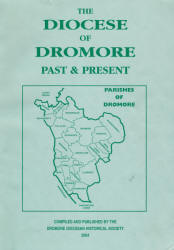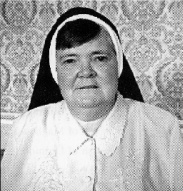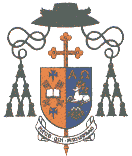|
 |
COMPILED
AND PUBLISHED
BY THE
DROMORE
DIOCESAN
HISTORICAL SOCIETY
2004 |

 As
the Dromore Diocesan Historical Committee was deliberating about how to
celebrate its Silver Jubilee most fruitfully, the motto of the Society's
Journal came to mind - "Quod scripta manet," (What is written remains),
- and it seemed appropriate to celebrate the Faith dimension of the
diocese by producing a history of the various parishes. As
the Dromore Diocesan Historical Committee was deliberating about how to
celebrate its Silver Jubilee most fruitfully, the motto of the Society's
Journal came to mind - "Quod scripta manet," (What is written remains),
- and it seemed appropriate to celebrate the Faith dimension of the
diocese by producing a history of the various parishes.
The question arose as to how to undertake this task.
The two viable alternatives were, either to compile an academic,
in-depth evaluation of the progress of each deanery and parish within
the Dromore Diocese, or to provide an interesting account of the history
of each parish which can be added to by groupings or families within
various districts. Taking into account the time-factor and the financial
constraints which are always present in worthwhile projects, it was
decided to adopt the latter approach to the compilation of the Diocesan
Book.
The task of compiling the parish chapters was, in
some instances, borne by members of the committee and, in others, local
parishioners agreed to contribute accounts for their particular
parishes. I thank the contributors very sincerely for the time and
effort they have spent with this important work and I congratulate them
warmly for the quality of their research and contributions.
It is my hope that the Diocesan History will
adequately reflect the richness and diversity of community life within
each parish and within the diocese by recording the depth, generosity
and quality of Faith of past - and present - generations of priests,
religious and faithful.
Beannacht D�, cumhdach na Maighdine agus
eadarghu� �r sinsear oraibh aile.
Sister Dr. Evelyn
Kenny, Chairman. November 2004

 The
history of the parishes contained in this book reflects the background
of the communities that make up the diocese of Dromore; this, in other
words, is the Church described `from below'. It is the story of each
parish, its people, its clergy and its institutions, as history has
shaped them and continues to shape them. In this foreword I want to look
at the parish from a theological perspective. I will reflect on what
parishes are and on the part that they play in the life of the Catholic
Church. I am addressing the question: "What is the future for parishes?" The
history of the parishes contained in this book reflects the background
of the communities that make up the diocese of Dromore; this, in other
words, is the Church described `from below'. It is the story of each
parish, its people, its clergy and its institutions, as history has
shaped them and continues to shape them. In this foreword I want to look
at the parish from a theological perspective. I will reflect on what
parishes are and on the part that they play in the life of the Catholic
Church. I am addressing the question: "What is the future for parishes?"
What is a Parish?
In Church law a parish is defined as `a certain
community of Christ's faithful stably established in a [diocese], whose
pastoral care, under the authority of the diocesan Bishop, is entrusted
to a parish priest as its proper pastor'. (Can. 515, par.!). While this
definition stresses the stability of parishes, the following section
provides a mechanism for the establishment, suppression or alteration of
parishes. A brief consideration of the history of parishes in Dromore
even in the last generation shows the importance of this; Mayobridge and
Burrell have been established as separate parishes, having formerly been
part of Clonallon; Dromara, while remaining a separate parish, no longer
has its own parish priest, and is served by the priests of the
neighbouring parish of Magheradroll. The amalgamation of other parishes
is a real possibility. It is clear that the pattern of parishes is not
static and reflects the ebb and flow of circumstances. The history of
parishes is a history of both stability and fluidity, and this will
continue to be so.
A Theology of Parish
In Christifideles laid, Pope John II's
apostolic exhortation on `the vocation and mission of the lay faithful
in the Church and in the World', (issued in 1988), there is a reflection
on the theological identity of a parish. The Pope acknowledges that
while the Church always has a universal dimension, it 'finds its most
immediate and visible expression in the parish' (n.20a). People
experience what it means to belong to the Church, above all, in terms of
their relationship with the parish community in which they live; they
are initiated into a parish community at Baptism, First Communion and
Confirmation; it is in that community that they witness the faith being
lived, celebrated in liturgy and handed on, both by personal
experience and in the formal setting of the parish school.
Pope John Paul II expresses the hope that `in the
light of faith all rediscover the true meaning of the parish, that is,
the place where the very `mystery' of the Church is present and at work
...' (n.20b). He stresses that `the parish is not principally a
structure, a territory, or a building. but rather 'the family of God, a
fellowship afire with a unifying spirit, a familiar and welcoming home,
the community of the faithful. Plainly and simply. the parish is founded
on a theological reality, because it is a Eucharistic community'
(n.20b). He continues:

This means that the parish is a community
properly suited for celebrating the Eucharist, the living source for
its upbuilding and the sacramental bond of its being in full
communion with the whole Church. Such suitableness is rooted in the
fact that the parish is a community of faith and an organic
community, that is, constituted by the ordained and other
Christians, in which the pastor - who represents the diocesan Bishop
- is the hierarchical bond with the entire [diocese] (ibid).
In other words, no parish community stands alone;
through the celebration of the Eucharist and the ministry of its parish
priest, it is linked to a network of parishes in the diocese. In church
law, parishes are clustered into deaneries (or vicariates). In Dromore
there are five deaneries: Newry, Clonallon, Seapatrick, Shankill and
Magheradroll. It is the task of the Dean (Vicar Forane) `to promote and
coordinate common pastoral action in the vicariate.' (Can.555, par. 1
.,n.1).
Pope John Paul II notes that although diocesan
organisations play an important role in spreading the faith, `in our day
the parish still enjoys a new and promising season' (n.20c). He cites
Paul VI:
We believe simply that this old and venerable
structure of the parish has an indispensable mission of great
contemporary importance; to create the basic community of the
Christian people; to initiate and gather the people in the
accustomed expression of liturgical life; to conserve and renew the
faith in the people of today; to serve as the school for teaching
the salvific message of Christ; to put solidarity in practice ....
the humble charity of good and brotherly works.
Pope John Paul 11 goes on to call for greater effort to
renew parish life:
So that all parishes ... may be truly communities
of Christians, [Bishops] ought to foster the following: a)
adaptation of parish structures according to the full flexibility
granted by canon law, especially in promoting participation by the
lay faithful in pastoral responsibilities .... For the renewal of
parishes and for a better assurance of their effectiveness in
practice, various forms of cooperation even in a structured way
ought to be fostered among different parishes in the same area
(n.20d).
From the above, two ideas emerge with particular
force: parishes are places where clergy and laity cooperate with each
other; parishes themselves need to co-operate with each other.
Parishes in the future
Arising from a series of `listening meetings' across
the parishes of the diocese during Lent 2003, `Core Groups' made up of
priests and the lay faithful in each parish have begun to reflect on the
pastoral needs and resources in their communities. It is my conviction
that, working in a spirit of co-operation and mutual
support and guided by the Spirit, these groups will
enrich the liturgical life of their parishes and in every way possible
foster new life in their communities. These `Core Groups' will also meet
at deanery level to support one another and to draw encouragement and
inspiration from one another. In this way, the vision of Pope John Paul
II will become a reality.
However, as parishioners plan for the future it will
be important that they are aware of the history of their community. I am
confident that many parishioners, both those who have deep roots in
their parish and those who have come to live in their parish more
recently, will find this book a great resource. I am confident too that,
for some, this work will be a stimulus to do more historical research.
The Dromore Diocesan Historical Society
In recent years in Ireland there has been a growing
interest in local history, in Church circles and generally in society.
Across the dioceses of Ireland historical societies, through their
meetings and journals, have helped to foster this interest and to inform
people about the history of their localities. I want to pay tribute to
the Dromore Diocesan Historical Society for all its work and, in
particular, for its contribution to the production of this book. I pray
God's blessing on its committee and members. I wish it continued success
in the years to come.

@
John McAreavey
Bishop of Dromo
DROMORE DIOCESAN HISTORICAL SOCIETY
FOUNDED 1977-78
| President: |
Most Reverend Dr. John McAreavey, Bishop of
Dromore. |
| Honorary Life-President:
|
Most Reverend Dr. F.G. Brooks, Retired
Bishop of Dromore. |
| Chairman: |
Sister Dr. Evelyn Kenny, Convent of Mercy,
Newry. |
| Honorary Life-Chairman:
|
Very Reverend Canon Thomas Mooney,
Drumgath. |
| Vice-Chairman: |
Mr. Kieran Clendinning, Lurgan. |
| Honorary Secretary:
|
Dr. Francis Xavier McCorry, Lurgan. |
| Honorary Treasurer:
|
Very Reverend Anthony Dean Davies, P.P.
Clonduff. |
| Journal Editor: |
Mr. Kieran Clendinning, Lurgan. |
| Committee Members: |
Reverend Fr. Andrew McMahon, C.C., Newry. |
| |
Mrs. Maria Clarke, Newry. |
| |
Mrs. Anne Canavan, Saval. |
| |
Mrs. Patricia Walsh, Saval. |
| |
Dr. Seamus McAteer, Forkhill & Newry. |
|
Past Committee Members: |
Mr. John Lennon, Loughbrickland. |
| |
Mrs. Kathleen Hill, Lurgan. |
| |
Mrs. Christine Fitzsimons, Warrenpoint. |
|
Past Committee Members, now deceased: |
Very Reverend Patrick Rooney, Drumgooland,
R.I.P. |
|
|
Very Reverend Bernard Treanor, Finnis,
Dromara, R.I.P. |
|
|
Dr. Jim Fitzsimons, Newry, R.I.P. |
|
|
Mr. John Joe Sands, Loughbrickland, R.I.P. |
|
|
Mr. Patrick Kearns, Newry, R.I.P. |
|
Honorary Committee Member, now deceased: |
Brother Thomas F. Beausang, Newry, R.I.P. |
|
|
|
 |